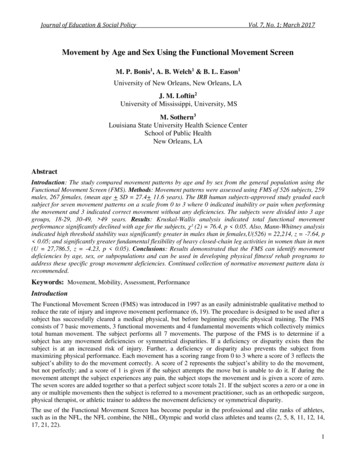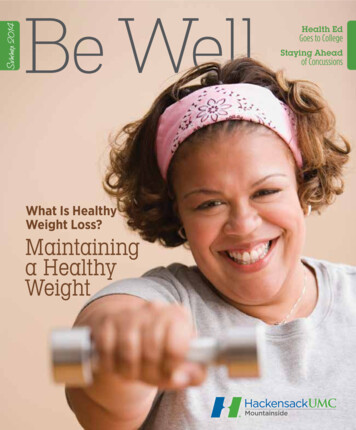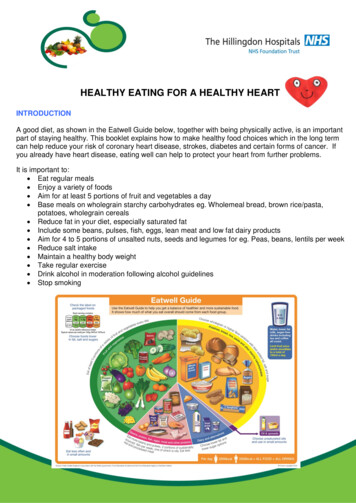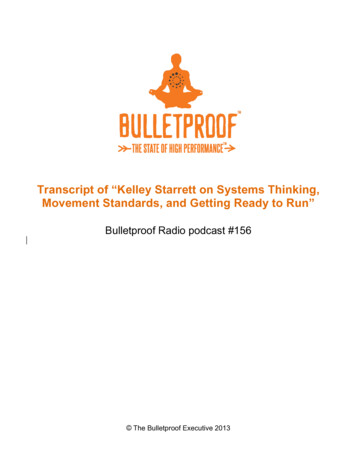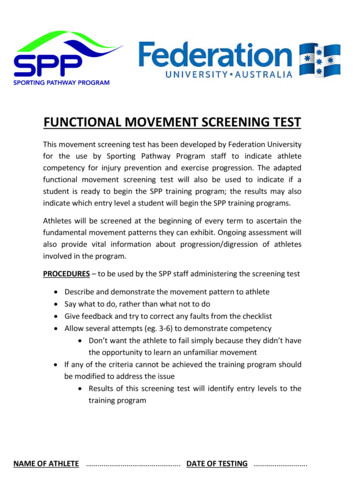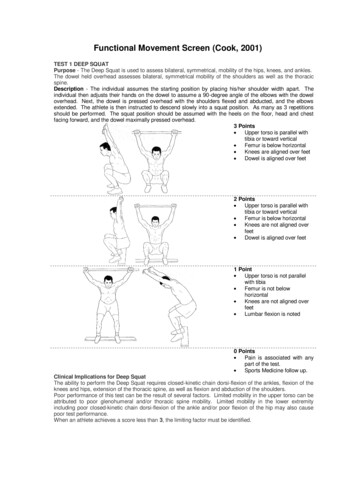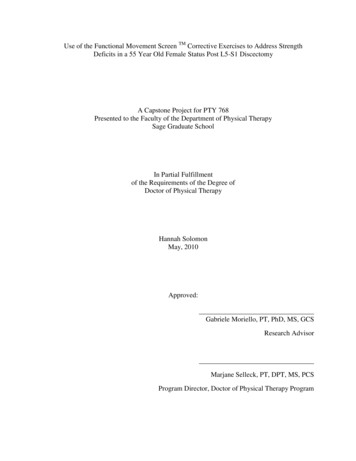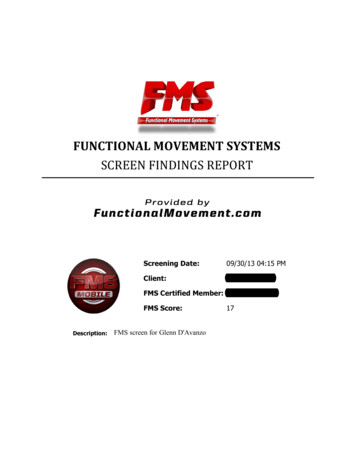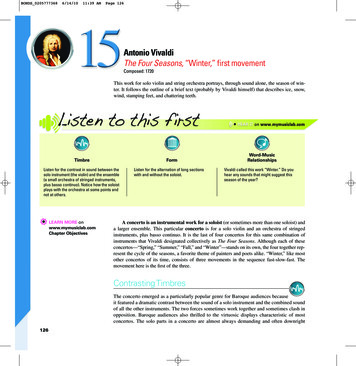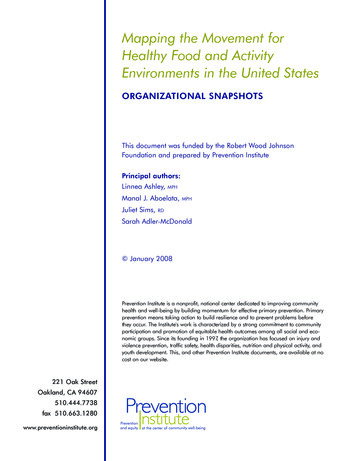
Transcription
Mapping the Movement forHealthy Food and ActivityEnvironments in the United Statesorganizational snapshotsThis document was funded by the Robert Wood JohnsonFoundation and prepared by Prevention Instituteprincipal authors:Linnea Ashley,mPhmanal J. Aboelata,Juliet Sims,mPhRdSarah Adler-mcdonald January 2008Prevention Institute is a nonprofit, national center dedicated to improving communityhealth and well-being by building momentum for effective primary prevention. Primaryprevention means taking action to build resilience and to prevent problems beforethey occur. The Institute's work is characterized by a strong commitment to communityparticipation and promotion of equitable health outcomes among all social and economic groups. Since its founding in 1997, the organization has focused on injury andviolence prevention, traffic safety, health disparities, nutrition and physical activity, andyouth development. This, and other Prevention Institute documents, are available at nocost on our website.221 Oak StreetOakland, CA 94607510.444.7738fax 510.663.1280www.preventioninstitute.org
AcknowledgementsPrevention Institute would like to thank each of the following individuals who gave generously of their time to provide us with theinformation, photos, and supporting materials that went into each organizational snapshot.Chris BedfordPresidentCenter for Economic SecurityJoe SchroederUrban OrganizerCommunity Farm AllianceRob SadowskyExecutive directorChicagoland Bicycle Federationmarnie Genre & max ElliotNew Orleans Food and Farm NetworkSally FlocksPresident, CEO, and FounderPedestrians Educating drivers on SafetyBerry FriesenExecutive director.Pennsylvania hunger Action CenterJen JamesAssociate directorThe Food Project of BostonRamon RamirezExecutive directorPiñeros y Campesinos Unidos del Noroeste(Northwest Treeplanters and Farmworkers United)Jennifer Lopezhealthy Living Outreach FacilitatorGet moving KernTim AdamsExecutive directorTeton Valley Trails and PathwaysKathryn LawlerConsultantLifelong Communities InitiativeWe would like to recognize makani-Themba Nixon, Praxis Project and Kolu Zigbi, Noyes Foundation for their thoughtful reflections and guidance during the start-up phase. We would also like to thank key informants from ypsilanti health Coalition, OneLess Car, deep South Center for Environmental Justice, and Piedmont Environmental Council, who gave generously of theirtime to describe their policy advocacy and community organizing efforts.Carol Chao, Janani Srikantharajah, Sam davidson, and Jesse Appelman were the Prevention Institute staff responsible formany hours of interviewing, data collection, and data analysis. Without their efforts neither the Map of the Movement northe Organizational Snapshots would have come to fruition. Thank you.iimAPPING ThE mOVEmENT FOR hEALThy FOOd & ACTIVITy ENVIRONmENTSwww.preventioninstitute.org
Table of Contentsoverview . . . . . . . . . . . . . . . . . . . . . . . . . . . . . . . . . . . . . . . . . . . . . . . . . . . . . 11. Community Farm alliance. . . . . . . . . . . . . . . . . . . . . . . . . . . . . . . . . . . . . . 32. get Moving Kern. . . . . . . . . . . . . . . . . . . . . . . . . . . . . . . . . . . . . . . . . . . . . 63. Chicagoland Bicycle Federation . . . . . . . . . . . . . . . . . . . . . . . . . . . . . . . . . 94. pennsylvania hunger action Center . . . . . . . . . . . . . . . . . . . . . . . . . . . . . 115. Piñeros y Campesinos Unidos del Noroeste(northwest treeplanters and Farmworkers United) . . . . . . . . . . . . . . . . . 136. lifelong Communities initiative. . . . . . . . . . . . . . . . . . . . . . . . . . . . . . . . . 157. the Food project of Boston . . . . . . . . . . . . . . . . . . . . . . . . . . . . . . . . . . . . 178. teton Valley trails and pathways . . . . . . . . . . . . . . . . . . . . . . . . . . . . . . . 199. Center for Economic security . . . . . . . . . . . . . . . . . . . . . . . . . . . . . . . . . . 2110. pedestrians Educating Drivers on safety . . . . . . . . . . . . . . . . . . . . . . . . . . 2311. new orleans Food and Farm network. . . . . . . . . . . . . . . . . . . . . . . . . . . 25Prevention InstituteORGANIZATIONAL SNAPShOTSiii
Forewordthe organizational snapshots captured in the following pages present innovative efforts of 11organizations advocating for improvements,predominantly in low-income neighborhoods andwith African American and Latino residents. Each ofthe 11 community groups take on tough policy andenvironmental change issues like increasing access tohealthy food, addressing safety concerns, and cultivating opportunities for walking and bicycling. In bothrural settings and urban neighborhoods throughoutthe country, these snapshots paint a picture of pervasivechallenges to healthy eating and active living andexplore creative solutions to improve health and quality of life.These 11 snapshots are part of a broader effort entitled, Mapping the Movement for Healthy Eating and Activity Environments in the United States: A Snapshot of theField funded by the Robert Wood Johnson Foundation. In December 2006, Prevention Instituteembarked on a national search for coalitions andorganizations advocating for change in communities ofcolor and in low-income neighborhoods. Our scan ofthe field involved interviews with numerous key informants which resulted in semi-structured interviewswith representatives of 312 organizations. The scanivincluded groups working on nutrition and physicalactivity advocacy and related issues like food security,sustainable agriculture, and the built environment, aswell as groups advocating to limit unhealthy exposures(e.g., tobacco, alcohol, and environmental toxins) and toexpand human rights (e.g., labor and housing rightsgroups).Of the more than 300 groups interviewed, the 11organizations profiled in this document representexamples of compelling policy advocacy, programmatic, and environmental change efforts designed to positively impact people’s lives and livelihoods. In thesesnapshots we hope that the reader will recognize interest and capacity among committed advocacy groups toapply their strategies, passion, and energy to improvingopportunities for healthy eating and active living intheir communities.Our hope is that these organizational snapshots canbe used to offer advocates, policy makers, funders, andcommunity residents with examples of how the inertia of active, engaged organizations and residents cantransform communities—make them healthier—through changes to policies, environments, and socialnorms.mAPPING ThE mOVEmENT FOR hEALThy FOOd & ACTIVITy ENVIRONmENTSwww.preventioninstitute.org
oVErViEwMapping the Movement for Healthy Food andActivity Environments in the United States:Organizational Snapshotsthe organizational snapshots include a description of the organizational setting, overview oftheir policy advocacy and environmentalchange efforts, discussion of significant challenges tothe work, and “quick facts” about each organization.The “quick facts” box in the upper right-hand corner of the first page of each snapshot draws data fromthe Mapping Database and provides the organization’slocation, policy jurisdiction (local, state or federal), policy orientation (engaged in policy, poised to do morepolicy work, education orientation); approach (environmental/ institutional or services/programs); strongequity focus; issue areas; policy domains; and websiteaddress.1. Community Farm Alliance: With a membershipbase of over 2,000, CFA spearheads policies to support family farming in rural Kentucky and createsaccess to healthy fresh fruits and vegetables amongurban,West Louisville’s primarily African Americanresidents through a blend of programs and policies.2. Get Moving Kern and Greenfield Walking Group:A parent-led walking group serves as the residenttask force to the Get Moving Kern coalition and isreversing barriers to healthy eating and safe walking in their rural, predominantly Latino community of Kern County, California.3. Chicagoland Bicycle Federation: In Chicago andthe surrounding region, this membership-drivenorganization works on Complete Streets policies,local bikeways, safe routes to school, and publicevents to rally for streets that will accommodatePrevention Institutebicyclists safely on their way to school and acrossthe city.4. Pennsylvania Hunger Action Center: This statewide advocacy center works at the nexus of nutrition, hunger, and poverty as it coordinates a network of nutrition activists and professionals toadvocate for statewide legislation to improveschool nutrition, increase participation in the FoodStamp Program, and increase the minimum wage.5. Piñeros y Campesinos Unidos del Noroeste (Northwest Treeplanters and Farmworkers United): In therural town of Woodburn, Oregon with a morethan 50% Latino population, the farmworkersunion has developed a strong organizing and advocacy history on labor and housing issues. Now,through its 5,700 members, the farmworkers,spouses, and children are also addressing healthyfood access and physical activity to help local residents eat better and move more.6. Lifelong Communities Initiative: This program ofthe Atlanta Regional Commission pays special attention to the needs of seniors as it works to improve community design and support city-wide ordinances to support better walking and transportation alternatives and healthy housing for seniors.7. The Food Project of Boston: Cultivating fruits andvegetables in an urban garden and on a suburbanfarm leased from the city at minimal cost, youthwork with The Food Project and participate in community-supported agriculture that brings healthyproduce to low-income residents throughoutBoston.ORGANIZATIONAL SNAPShOTS1
8. Teton Valley Trails and Pathways: Looking to finda balance between responsible development, landconservation, and a physical activity friendly environment, advocates and residents of this rural,sparsely populated city work together to advancelocal and regional policies that will guide development for years to come.10. Pedestrians Educating Drivers on Safety: With aprimary goal of increasing pedestrian safetythroughout the Atlanta region, this organizationhas won policy victories and manages an innovative web-based system that allows residents toreport barriers to safe walking directly to theappropriate city or county agency.9. Center for Economic Security: Working intensivelyin the low-income city of Muskegon, Michigan,this relatively new organization is galvanizing support for a local, sustainable food system and hopesto get a statewide initiative on the 2010 ballot thatwill declare healthy, sustainable food as a right forevery Michigan resident.11. New Orleans Food and Farm Network: HurricaneKatrina was a recent memory when food scarcitybecame a frightening reality for many residentswho already lacked easy access to healthy foodsbefore the disaster. A food mapping effort startedout as a short-term response to residents’ need toget access to soup kitchens, grocery stores, or foodpantries and now has become a tool for understanding—and filling—gaps in access to healthyfoods and community gardens.2mAPPING ThE mOVEmENT FOR hEALThy FOOd & ACTIVITy ENVIRONmENTSwww.preventioninstitute.org
CoMMUnity FarM allianCEBridging rural farm policy with urbanfood accessFor Community Farm Alliance (CFA), the health andprosperity of Kentucky’s urban residents is inextricably linked to a thriving rural economy. Using a blendof economic development, youth development, andcommunity development principals, CFA promotessales and consumption of food grown by rural familyfarmers. The group hopes to increase access to healthy,affordable food throughout Kentucky, including thestate’s urban, African American communities. Theorganization’s state-level policy advocacy targets institutional and financial levers to create a more favorable climate for rural farmers. At the same time, CFA is working to create incentives for neighborhood corner storesto carry produce and has helped launch a number ofprograms and local farmers’ markets to improve urbanfood availability.Created in response to the farm crisis more than 20years ago, CFA maintains its roots in policy advocacyFARmERS mARKETS PROVIdE LOCAL mARKETSFOR FARmERSPrevention InstituteQUiCK FaCtsloCation . . . . Louisville, KypoliCy JUrisDiCtionn Stateo Localo FederalpoliCy oriEntationn Policyo Poisedo EducationapproaChn Environmental/Institutional o Services/ProgramsEQUity FoCUs . . . . . StrongissUE arEas. . . NutritionpoliCy DoMainsn Agriculture/Sustainable Food Systemsn Food Access/Anti-hungern healthy Food PurchasingwEBsitE . . . . . . www.communityfarmalliance.organd empowering people to engage in the legislativeprocess. In the mid 1980s many Kentucky farmerswere on the verge of losing their land. Reduceddemand for tobacco, an influx of new residents, andincreased real estate costs threatened to put many ofthe state’s farmers out of business. In 1985, CFAstepped in to establish a credit hotline that allowedthousand of farmers to stay on their land and make thetransition away from tobacco. Many Kentucky counties—dubbed tobacco dependent—have relied on theeconomy generated by the growth and sale of tobaccofor decades. In 2000, CFA won a tremendous victorythat had been many years in the making. CFA ralliedfor a number of provisions in the state’s Tobacco Settlement, including the establishment of local planningORGANIZATIONAL SNAPShOTS3
CFA hELPS KENTUCKy FARmERS FINd ANddEVELOP NEW mARKETSboards, a state-level Agriculture Development Board,and a set of accountability measures to support familyfarming and diversified farming practices (e.g., multiplecrops, growing organic). CFA’s goal is to ensure thatfamily farmers are engaged in a democratic process todetermine how land will be used and how the 1.7billion awarded to Kentucky will be spent over thenext 25 years. CFA will continue to serve as a watchdog for policy implementation and resource
Community Farm Alliance Rob Sadowsky Executive director Chicagoland Bicycle Federation Jen James Associate director The Food Project of Boston Jennifer Lopez healthy Living Outreach Facilitator Get moving Kern Kathryn Lawler Consultant Lifelong Communities Initiative We would like to recognize makani-Themba Nixon, Praxis Project and Kolu Zigbi, Noyes Foundation for their thoughtful reflec .
